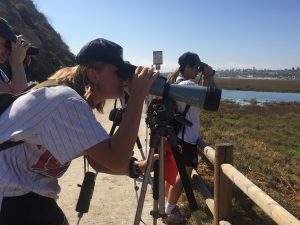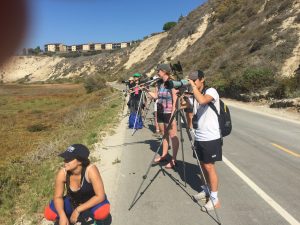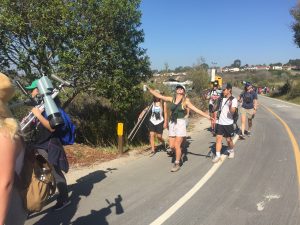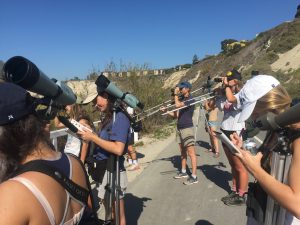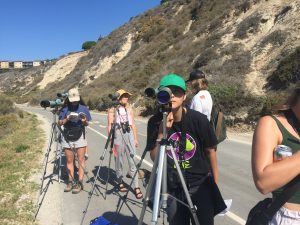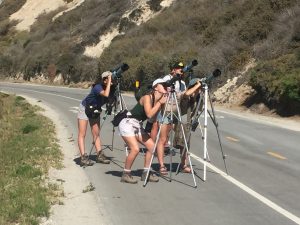This blog post was written by students in Avian Ecology, Fall 2018 about our field trip to Newport Back Bay
The History and Significance of the Newport Back Bay.
Newport Back Bay serves as a stopover site for many birds taking part in the Pacific Flyway. However, in the 1960s this critical location was on the brink of disappearing with plans for new residential construction. It was only through the efforts and organizing of concerned citizens that construction was prevented and the Bay was listed as an Ecological Reserve. Today, many birds still make use of these wetlands and students and bird-lovers can spend their time admiring the species diversity and beauty this bay has to offer (Newport Bay Conservancy).
Shorebird Migration
Migrating birds can travel thousands of miles converging on key stopover sites along the way to rest, eat and breed. Amongst these are diverse group of shorebird species, migrating birds that cover impressive distances along the North American Pacific Flyway (Ehrlich et a., 1988). These birds are especially vulnerable during migration because (1) migration is a set behavior that they can’t change from one day to the next, and (2) starvation and fatigue are constant threats. Stopover sites like the Newport Back Bay are therefore critical for the continuation of this migrating behavior, providing birds with familiar landing sites to rest and eat. However, many of these stopover sites are increasingly vulnerable to environmental and human disturbances (Galbraith et al., 2002).
Wetlands
Wetlands are essential stops for migratory birds, from shorebirds and waterfowl to seabirds and raptors. The health and size of a wetland can determine its carrying capacity as a foraging stop on energetically demanding migrating pathways (Evans and Dugan 1984, Goss-Custard 1996). Anthropogenic pressures such as pollution, habitat loss, and climate change put wetlands in jeopardy, making places like Newport Back Bay all the more important (Galbraith et al., 2002).
Professor Karnovsky holds this little wildlife sanctuary close to her heart — she has been going there since she attended grad school at UC Irvine. She appreciates the chance each year to go back and see the many migrating birds, which change each year, and to see the excitement that this special place can ignite in students seeing it for the first time.
“I knew there were a lot of birds that used the flyways but this put into perspective the amount of species that pass by every year,” says student Cody.
Our trip!
During our classes, we discussed migration extensively, touching on specific obstacles that migrating birds face during their journey. As a key stopover site for many migrating birds, Newport Back Bay allowed us to take what we had discussed in class out into the “real world”. We took a Friday afternoon to drive over to the bay and, though we did not stay for very long, we made the best of our time there. We were able to observe the behaviors of these birds and the number of species of birds present in the bay in real time. Truly, it was an amazing experience for all of us.
We carried our individual binoculars along with our field guides and field notebooks. We also took turns carrying scopes that we set down when we noticed a bird. Bird scopes allowed us to see more in detail the individual characteristics of different birds. While walking, students called out any birds they saw, but most of our in-depth observations were made along the banks of the estuary.
In our last hour, we drove back down south and rented out kayaks. A few students had never kayaked before, but we were all excited to continue to explore everything that surrounded us. By kayaking in the bay, we were literally able to immerse ourselves into this habitat. We observed birds along the banks, on the water and above in the sky while we were kayaking, but were only able to physically record the species we had seen once we were out of the water! During this part of the trip, we also saw a group of people that were conducting research on the shore, indicative of the scientific importance of the bay.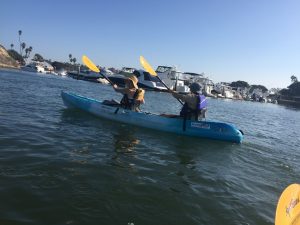
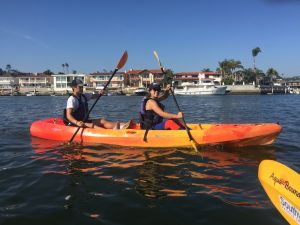
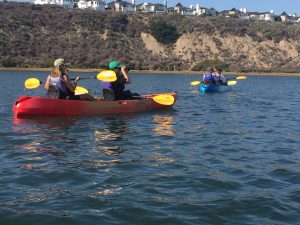
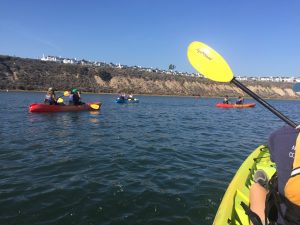
Birds Sighted
We accumulated an impressive list of birds sighted. Some highlights included a Clark’s grebe skimming along the surface of the water and doing a fun, above-water dance, multiple snowy egrets, the least sandpipers that travel so incredibly far, despite their small size, an osprey right above us as we walked around back bay, two ospreys that swooped down towards us from their heights in the sky, and getting impressively close to some great blue herons on our kayaks.
Student + Professor Experiences:
We asked students on the trip what their favorite part was. Cody, a sophomore at Pomona really “enjoyed the kayaking.” Kyra agreed, and appreciated “getting to be in nature, having the time to take it all in.” It is easy to get caught up in the business of life, and forget to take a moment to watch the excitement of the nature around you. As Lao Tzu, and ancient chinese philosopher says, “nature never hurries, yet everything gets accomplished.” It was quite a treat to spend an entire afternoon at this special spot. Many of us saw species we’d never seen before, or even known existed before this class. And then to imagine how far they’d come to rest in the sanctuary of Newport Back Bay? Taking a moment to step back and observe put things into perspective. “There is a lot more diversity than is noted at first glance in a certain place,” remarks Kyra. The little things can make a big difference, too. Nina was shocked at the striking size difference between the tiny plovers and sandpipers and the other shorebirds like the willets. In conclusion, I think that all the students of avian ecology can agree that the best way to learn about shorebird migration is to observe it first hand!

